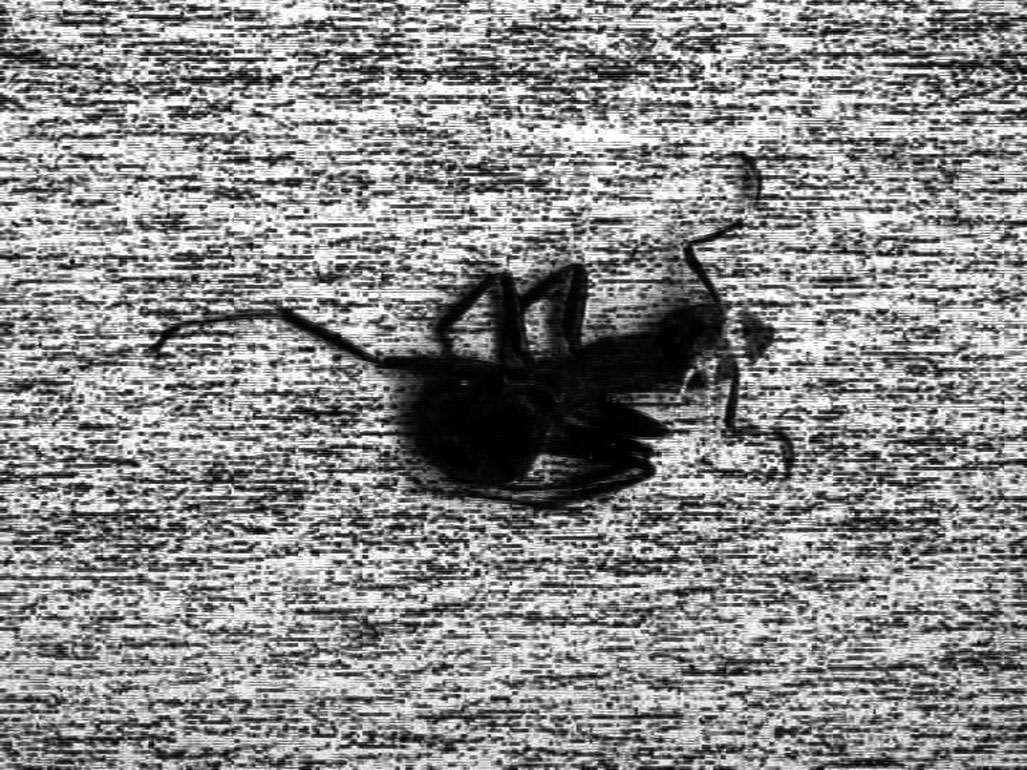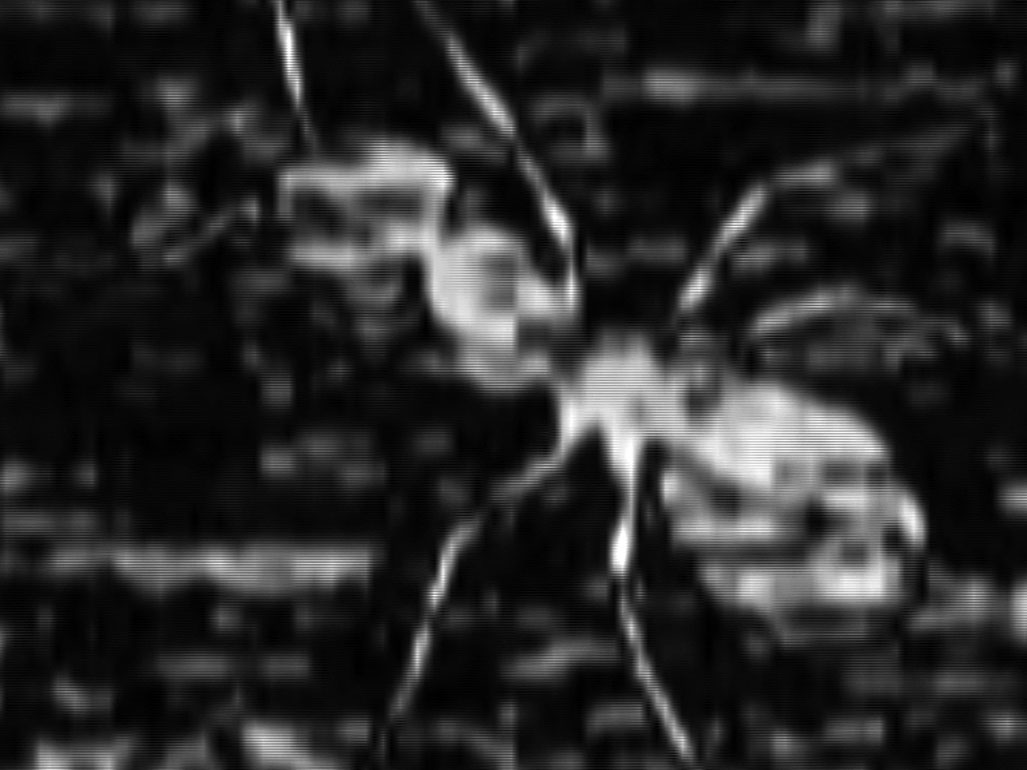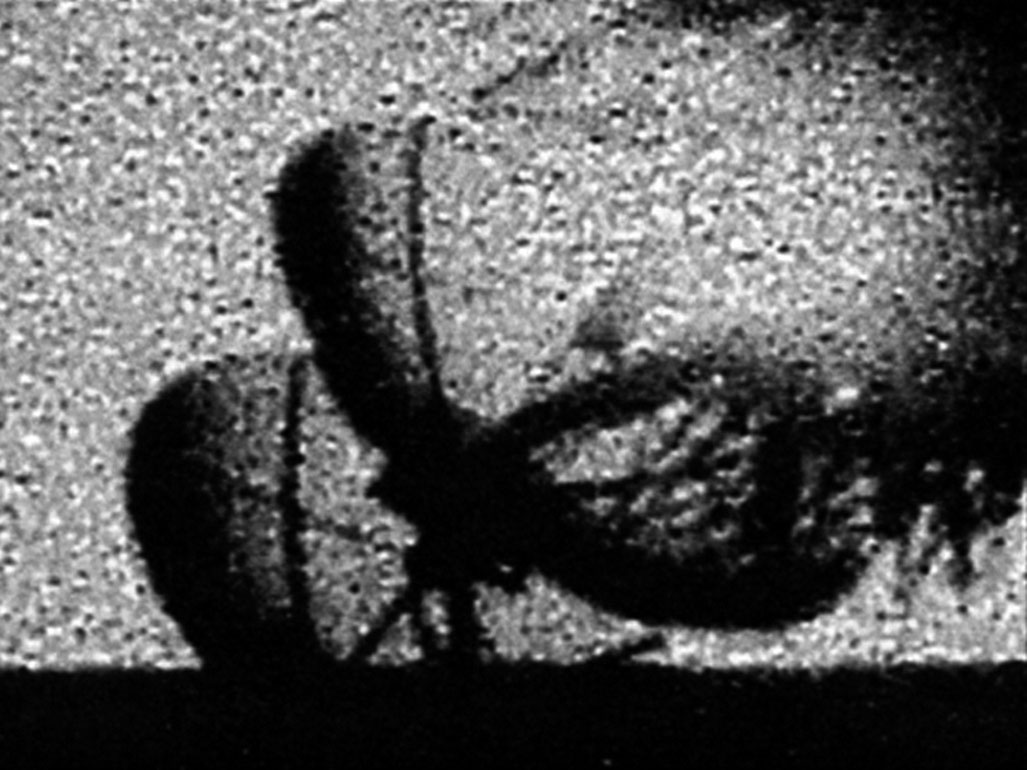Ground Control
Ground Control is a rough video miniature. It begins with the simplest and most fundamental thing the electronic moving-image machine has to offer: the uncontrolled beam of electrons directed across a photoelectric layer of cesium oxide lining a Braun tube, or snow.
Recording this chaos involves a fascination that existed during the early days of film: the repeatability of a unique event. A visual sequence which has never before existed and will never happen again becomes reproducible, thereby losing the status of the chaotic. This idea, a result of the desire to control an uncontrollable world, is the beginning of the chain of associations in this video, which randomly acting ants push their way into. The image of them crawling is manipulated in the reproduced images, distortion of their movement is forced upon them. The insects become monsters when, after being locked into the frame, they suddenly burst into the (snow)storm as a sequence of individuals.
This echoes the atmosphere of terror in the so-called bug movies of the fifties ("Them!," "Tarantula," etc.): Nature goes wild as a result of scientific experiments, taking its revenge on humankind in the form of giant insects.
The snow is carried over to a satellite antenna, a fuzzy outline of which appears in the picture:
They are, so to speak, brought back to earth (and reality?) there, those invisible waves that transport the images, the invisible force that controls them and the power they generate. In a technological sense waves now serve as a vehicle for moving images. As the movement of the surface of water, they represent a constantly changing visual spectacle, and through them the video descends into the images´ snow in the end, thereby returning to its beginning.
(Siegfried A. Fruhauf)
Translation: Steve Wilder
Ground Control invents the digital equivalent of Schwitters’ Merzbau: a stylistic of the parasite or bug in the program, as if imaged by ants. Ground Control and its radar field could be Marconi’s nightmare as, stationed in Cornouailles, he listened for whole nights to the electromagnetic waves that he awaited in their broadcast from Canada, and which he could only pick up as a surging static while his anten- nae swayed back and forth at the mercy of the winds.
(Nicole Brenez)
Ground Control, Texte français
Il y a dans l'enregistrement de ce bruit chaotique une fascination pré-cinématographique : la répétabilité d'un processus singulier. Un enchaînement visuel, n'ayant jamais existé auparavant et ne se renouvelant jamais à l'identique, devient reproductible et cesse par là-même de relever du chaos. Cette idée répond au désir de maîtriser un monde incontrôlable. Ainsi s'enclenche la chaîne d'associations de cette vidéo, qu'envahissent des corps de fourmis mus par instinct. Dans les images reproduites, leurs déplacements ont été manipulés par vidéo numérique, leurs mouvements soumis à un effet d'étrangeté. L'insecte se transforme en monstre lorsque, collé et enfermé dans le cadre, il finit soudain par exploser en une multitude d'individus propulsés dans la tourmente (de neige). Clin d'il à l'atmosphère d'épouvante sortie tout droit des films de monstres géants des années 1950 (Des monstres attaquent la ville, Tarantula...) : la nature détraquée par les expériences scientifiques se venge de l'espèce humaine en générant des insectes gigantesques.
Le bruit d'image se propage à une antenne parabolique dont les vagues contours apparaissent à l'écran : c'est alors que sont ramenées sur le terrain de la réalité les ondes invisibles qui transportent les images, l'invisible qui les contrôle et les forces qui s'expriment à travers elles. Au sens technologique du terme, les ondes servent aujourd'hui de support aux images animées. Désignant les vibrations se propageant à la surface de l'eau, elles sont un jeu visuel en perpétuelle évolution. De ces ondes-là, la vidéo en revient finalement au bruit d'image. Retournant ainsi à son point de départ.
Siegfried A. Fruhauf
Traduction: Françoise Guiguet



